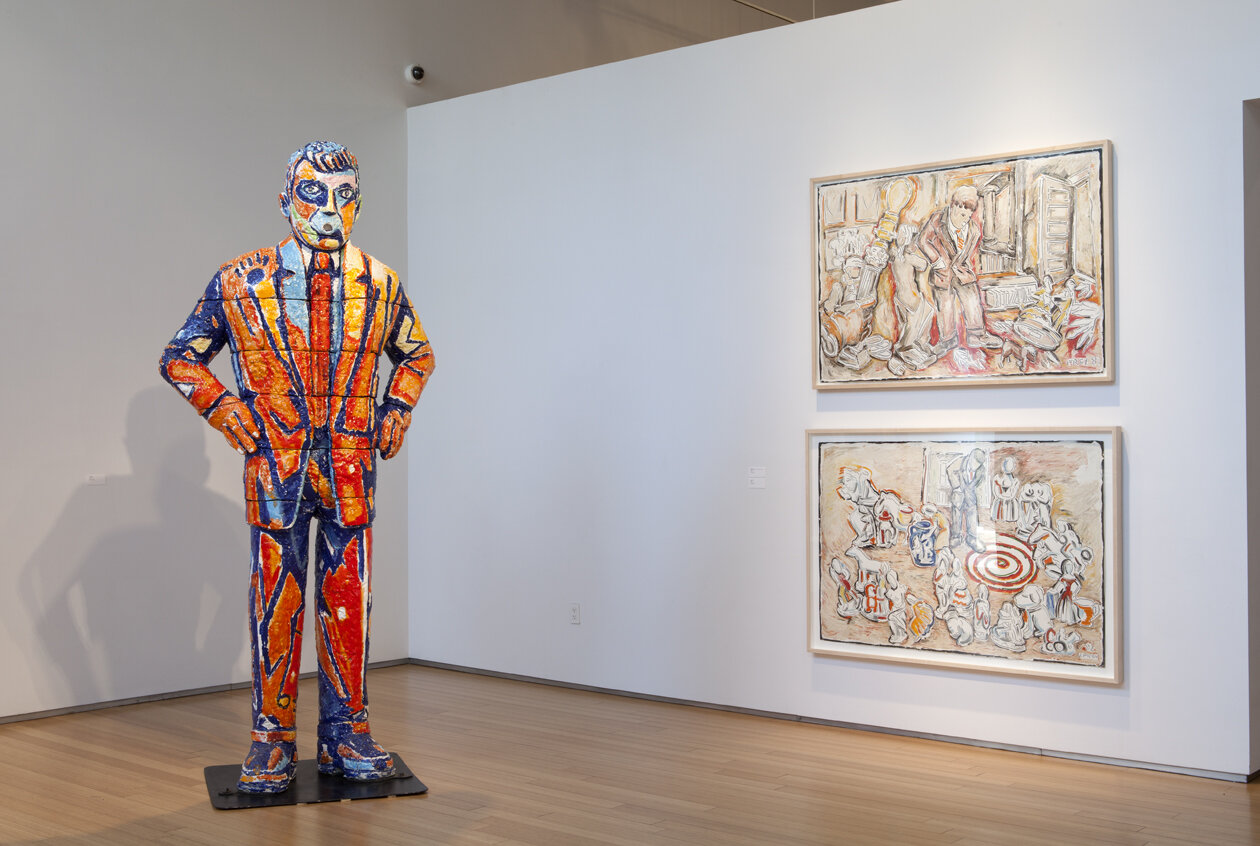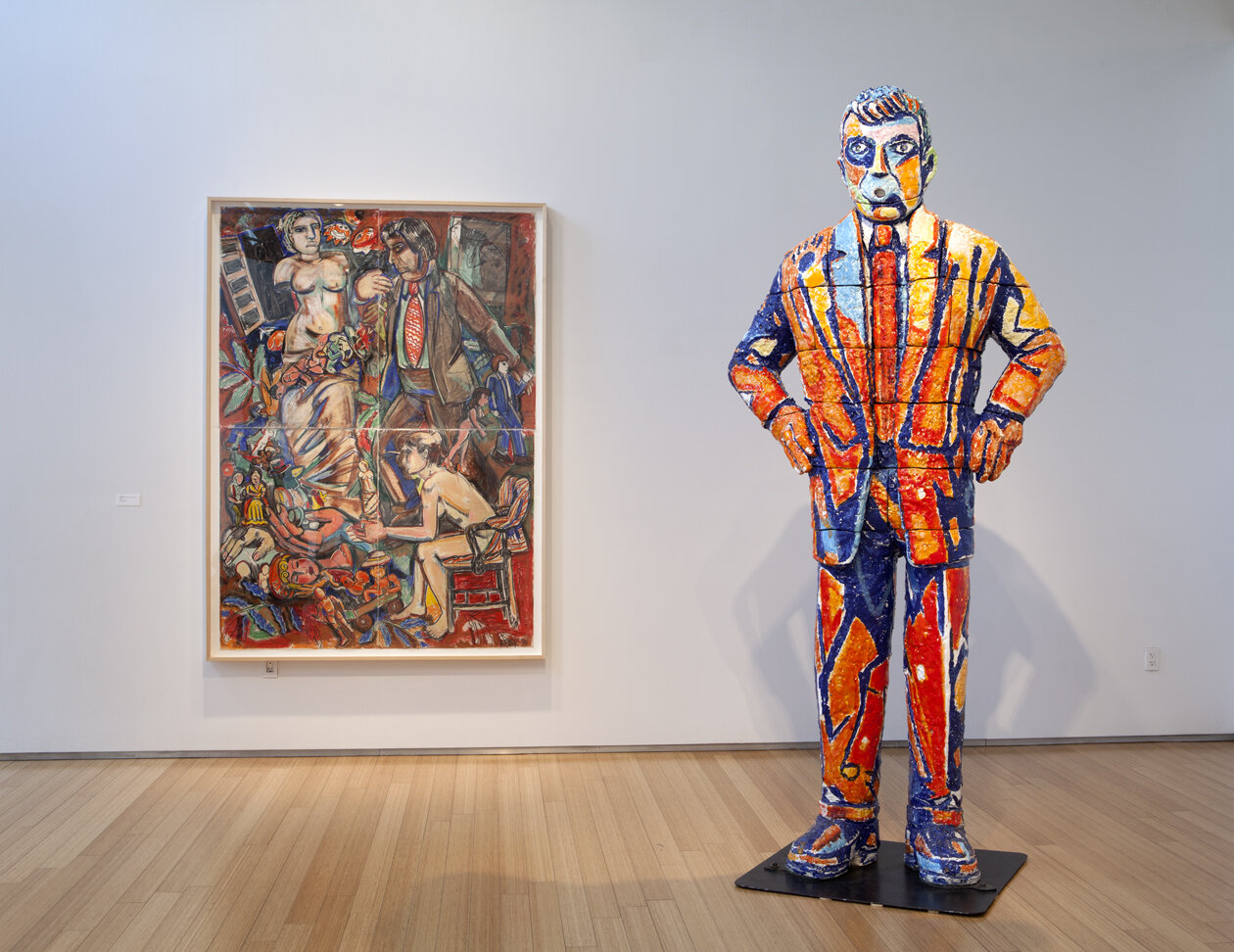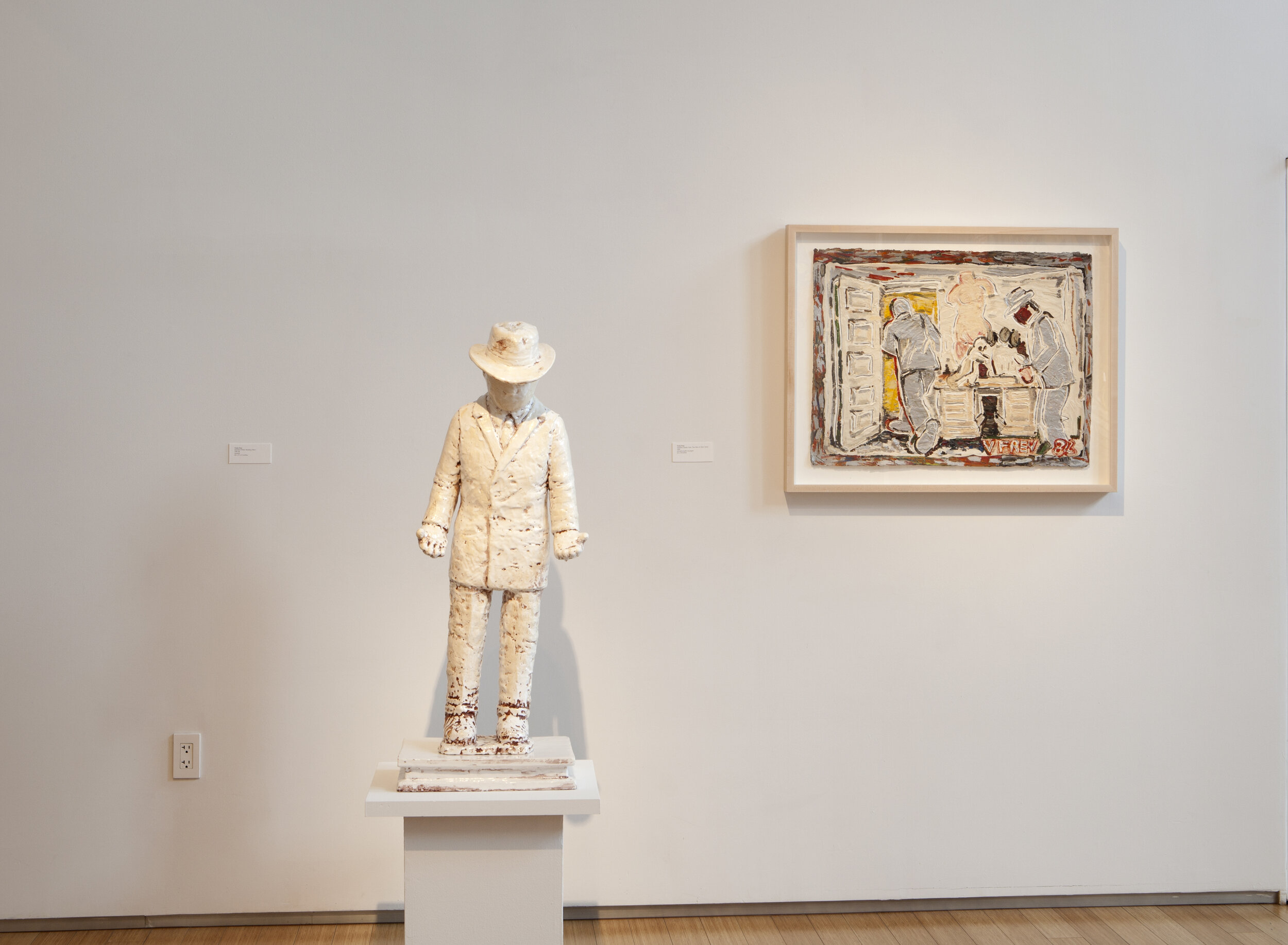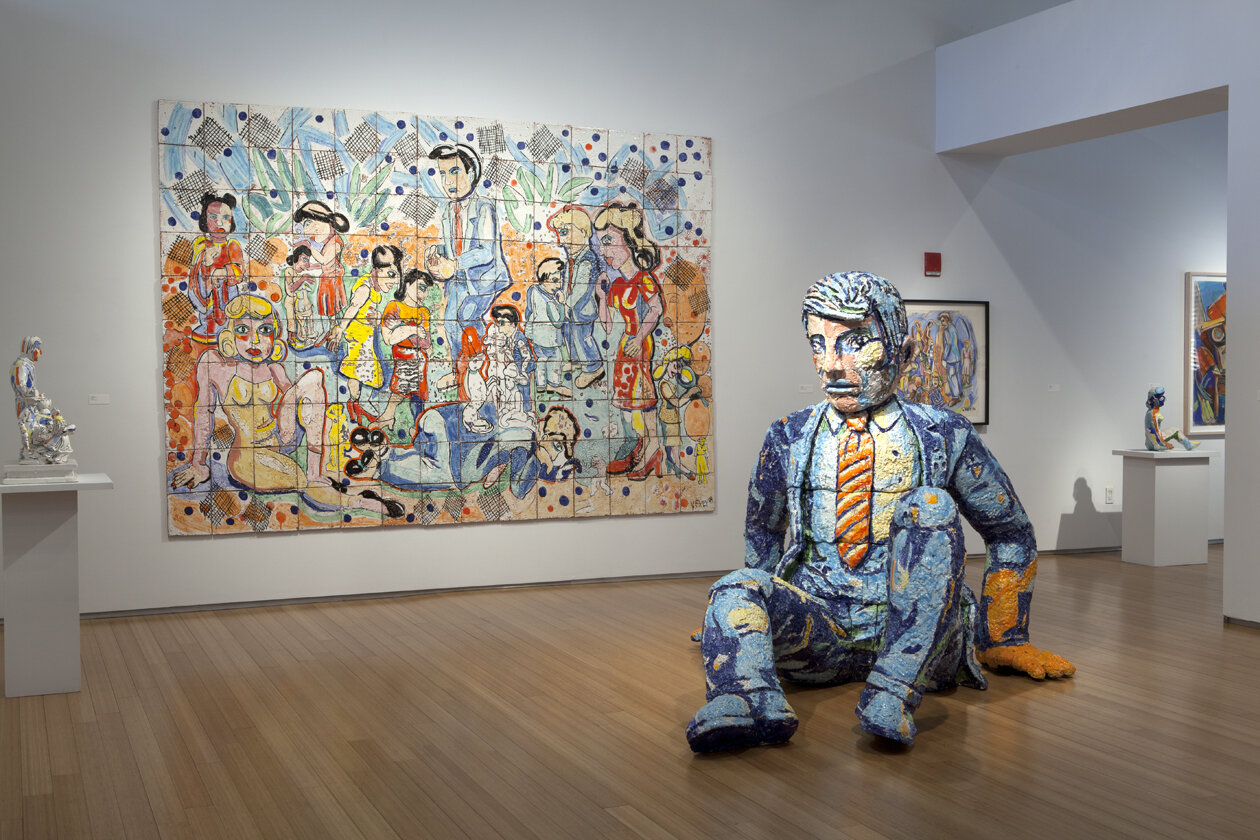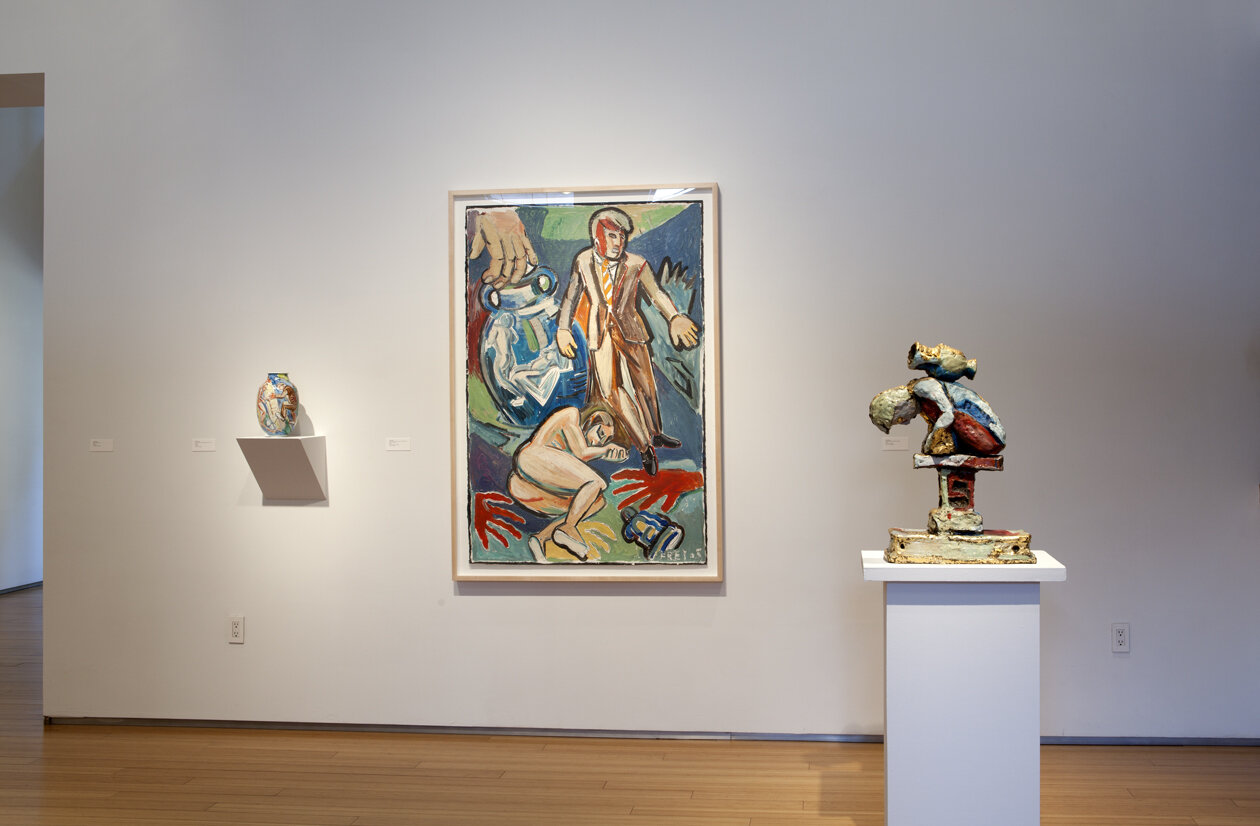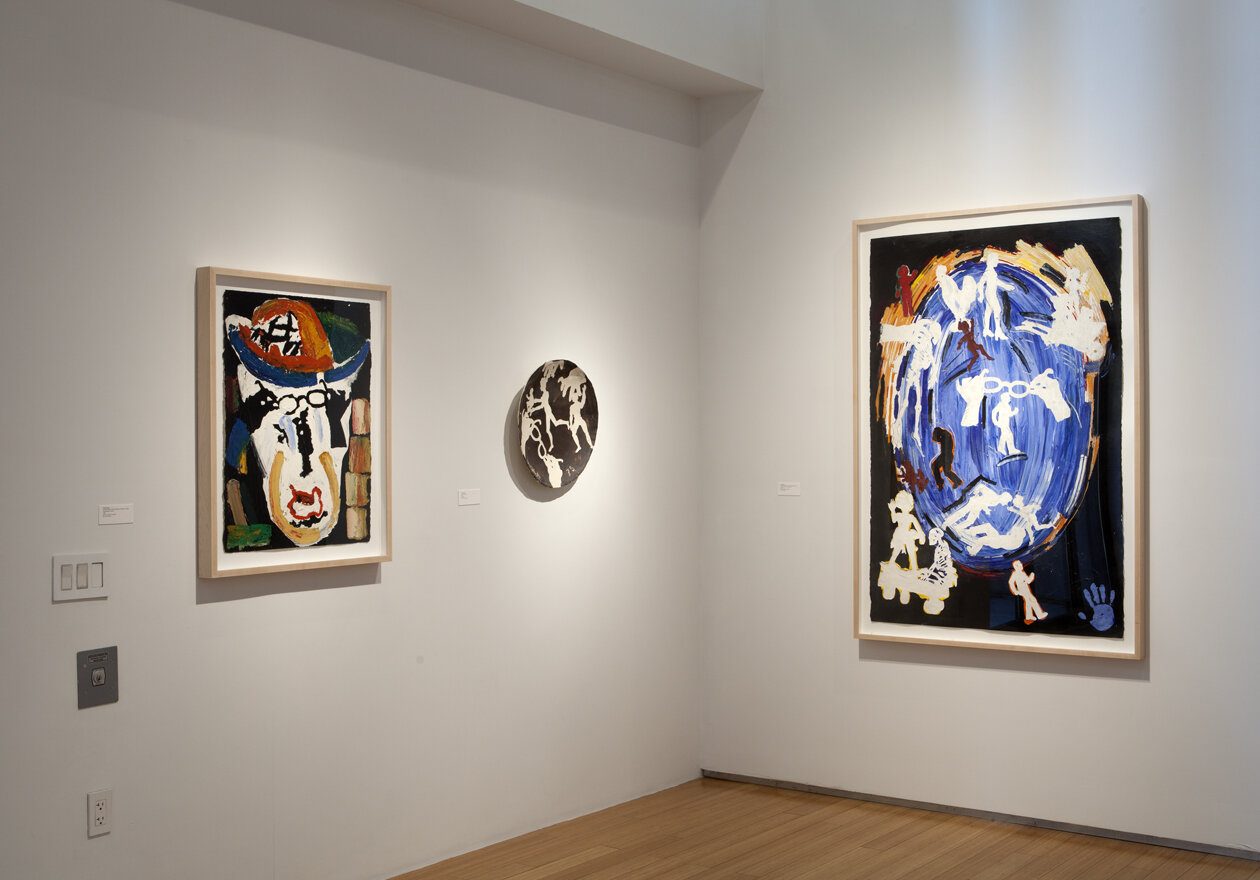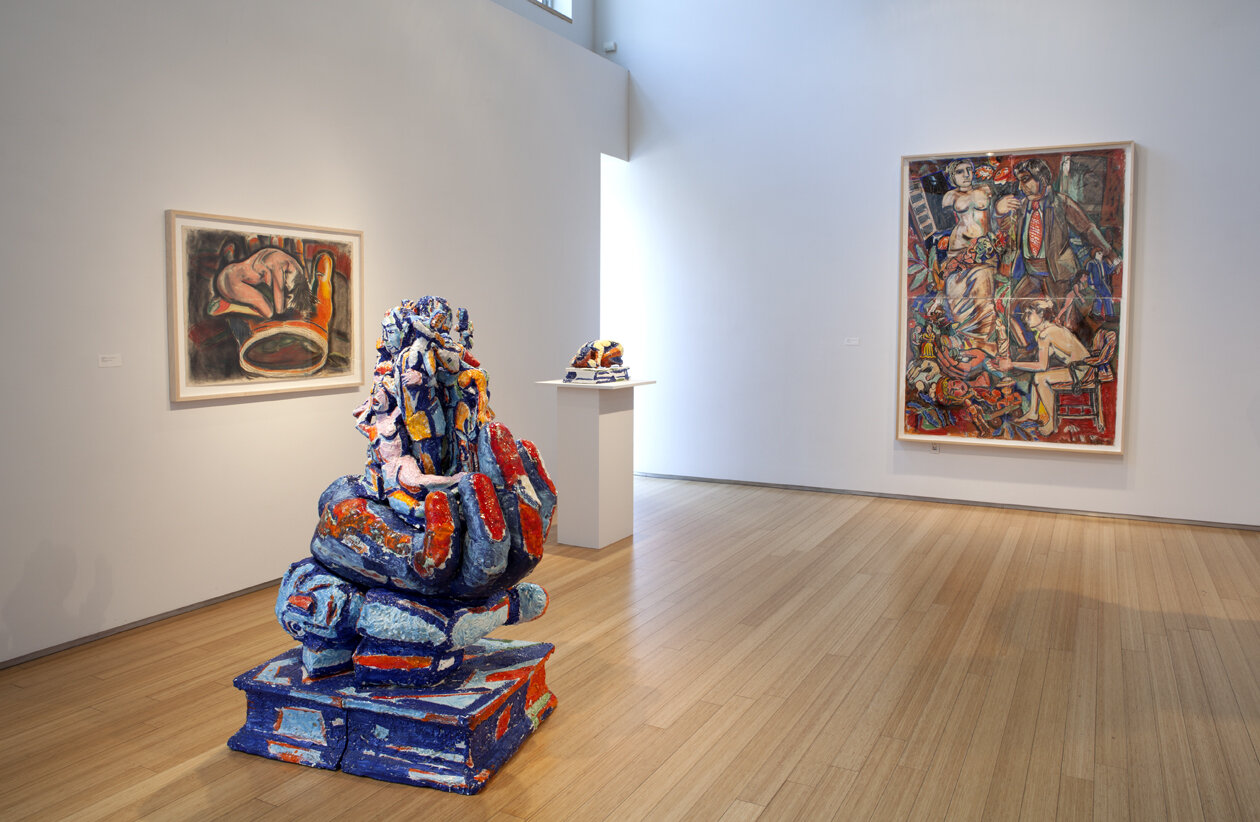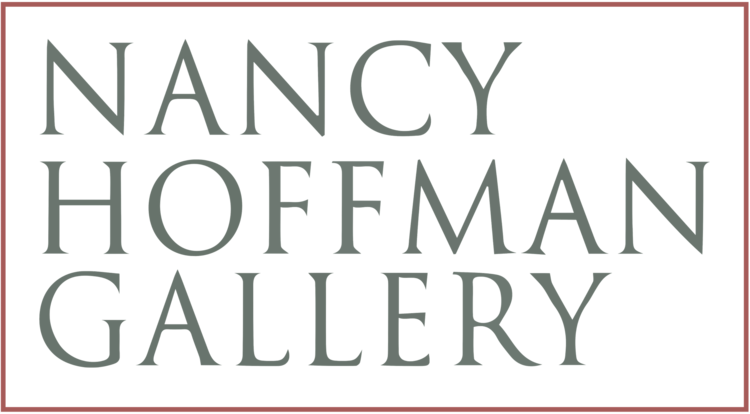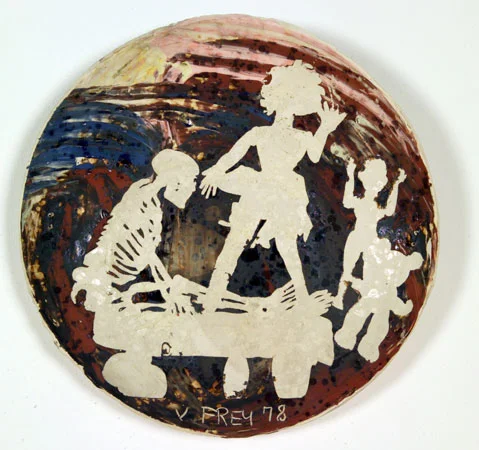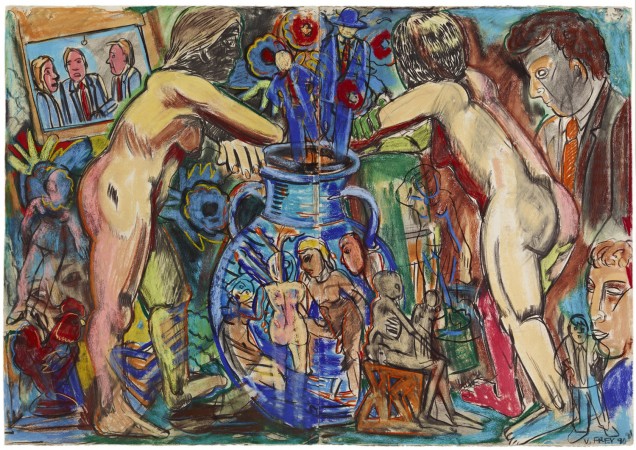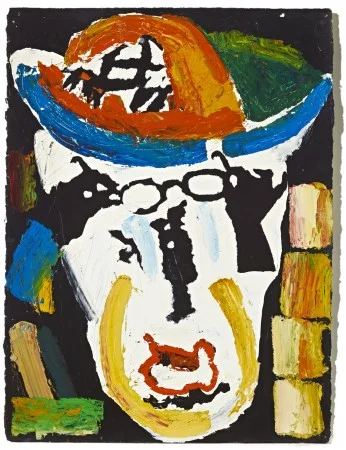Viola Frey: Echoes of Images
September 6 — October 20, 2012
“Echoes of Images,” a posthumous show of works by Viola Frey in sculpture, drawing, painting, bronze and glass, opens the Fall season at Nancy Hoffman Gallery on September 6th and continues through October 20th. Viola Frey, known for her larger-than-life ceramic figure sculptures, had a vocabulary of images all her own. “Every Man” in his blue power suit, “Every Woman” in her birthday suit, were her two most identifiable icons. “Echoes of Images” honors the artist’s vision and vocabulary with works in two dimension and three dimension with parallel images. Frey worked fluidly back and forth between her creations of sculpture, drawing and painting. Works from Frey’s Estate, dating back to the ‘70s, in small scale and grand scale fill the gallery, communicating Frey’s love of the human figure, along with her focus on certain objects and subjects that she used over and over in her work. Most of the works in “Echoes” have never before been exhibited.
“Standing White Man in Hat” is depicted in a 4-foot high hand-built sculpture, a haunting quiet figure that presages the artist’s 3 white glazed monumental works from her 2004 final body of work, a standing man--almost 11 feet in height, a seated woman--over 6 feet in height, and an urn--7 feet tall. “Standing White Man” is echoed in a painting on paper entitled “Studio View, Two Men in Silver Suits.” Two men stride through a room filled with energy and gesture. One of the men wears a suit and hat like the “Standing White Man,” the other strides through the doorway, escaping from the swirl of creative activity. In a plate entitled “HK in Doorway, Artist’s Hand Prints,” a similarly suited and be-hatted figure stands in a doorway, stopped in his tracks, surrounded by painterly strokes; Frey’s hands are visible on the left and right sides of the plate. From sculpture to plate to painting on paper, the image of man with hat echoes--a motif, a leitmotif, an unforgettable figure.
In several oil paintings on paper a man in a power suit looms large looking down at his world, hands on hips; he surveys a kingdom of figures and figurines based on the artist’s figurine collection. For years Frey frequented flea markets around Oakland, bringing home objects she could carry on the bus. She created a figurine museum in her home, lining closets with shelves to house the porcelains. Many of her flea market acquisitions became subjects in her paintings and sculptures. Some figurines appear in many guises, favorite images: the Venus de Milo, the horse, the dog, the rooster, a Wedgwood couple, an urn, a blond bobbed head of style from the ‘50s, Raggedy Ann, among others. Echoing the man in his power suit in Frey’s paintings is “Little Big Man,” a monumental sculpture, 10 feet in height. “Little Big Man” stands tall and proud, his mouth forming an “o,” perhaps exclaiming, perhaps singing, perhaps about to whistle, glazed in a vivid palette of reds, oranges and blues.
A small sculpture of a seated nude woman with one leg extended like a ballerina sits in front of a primary colored high-key pastel, depicting a woman in the same position. As one gazes back and forth between painting and sculpture, one is struck by Frey’s command of form and her desire to abstract form through her use of color. Frey was as devoted to color as she was to the human figure. She used color as a tool to abstract the forms she carefully hand-built, thus, the body became a vehicle for her patchwork of color dancing across the surface, the color communicating the human spirit and zest for life one senses in all of Frey’s oeuvre.
The artist’s work has been widely shown throughout the country at the Albany Museum of Art, Georgia; Anchorage Museum of History and Art, Alaska; The Arkansas Arts Center, Little Rock; Art Museum of South Texas, Corpus Christi; Avampato Discovery Museum, Charleston, West Virginia; Bayly Art Museum, Charlottesville, Virginia; Brevard Museum of Art and Science, Melbourne, Florida; The Butler Institute of American Art, Youngstown, Ohio; Louise Wells Cameron Art Museum, Wilmington, North Carolina; Center for the Arts, Vero Beach, Florida; Chicago Public Library Cultural Center, Illinois; Crocker Art Museum, Sacramento, California; Dahl Fine Arts Center, Rapid City, South Dakota; DeCordova and Dana Museum and Park, Lincoln, Massachusetts; di Rosa, Napa, California; Fresno Museum of Art, California; Grounds for Sculpture, Hamilton, New Jersey; Heckscher Museum, Huntington, New York; Hirshhorn Museum and Sculpture Garden, Smithsonian Institution, Washington, D.C.; Hudson River Museum, Yonkers, New York; Indianapolis Museum of Art, Indiana; Kreeger Museum, Washington, D.C.; Madison Art Center, Wisconsin; Marion Koogler McNay Art Museum, San Antonio, Texas; Mobile Museum of Art, Alabama; Montgomery Museum of Fine Arts, Alabama; Museum of Arts and Design, New York; Museum of Arts and Sciences, Macon, Georgia; Museum of Fine Arts, Boston; National Museum of Ceramic Art, Baltimore, Maryland; Newhouse Center for Contemporary Art, Snug Harbor Cultural Center, New York; Norton Museum of Art, West Palm Beach; Oakland Museum of Art, California; Pewabic Pottery, Detroit; Phoenix Art Museum, Arizona; Portland Art Museum, Oregon; Queens Museum, New York; St. Louis Museum of Art, Missouri; San Francisco Museum of Modern Art, California; Santa Barbara Museum, California; Seattle Art Museum, Washington; Smithsonian Institution, Renwick Gallery, Washington, D.C.; Tucson Museum of Art, Arizona; Virginia Museum of Fine Arts, Richmond; Western Gallery, Western Washington University, Bellingham; Whitney Museum of American Art, New York; Wichita Center for the Arts, Kansas; among others; and abroad at the American Center, Paris; Hall du Centre National des Arts Plastiques, Paris, Victoria and Albert Museum in London; and in Japan at Daimaru Museum of Art, Osaka-Umeda; Hiroshima City Museum of Contemporary Art; Isetan Museum of Art, Tokyo; LaForet Museum, Koto-ku, Tokyo; The Museum of Ceramic Art, Hyogo; The Museum of Contemporary Art, The Shigaraki Ceramic Cultural Park, Shiga.
Viola Frey’s work is represented in numerous public collections, among them; The Arkansas Arts Center, Little Rock; Art Museum of South Texas, Corpus Christi; The Butler Institute of American Art, Youngstown, Ohio; Louise Wells Cameron Art Museum, Wilmington, North Carolina; Carnegie Museum of Art, Pittsburgh; The Contemporary Museum, Honolulu; The Detroit Institute of Arts, Michigan; Everson Museum of Art, Syracuse, New York; Fabric Workshop and Museum, Philadelphia; Fine Arts Museum of San Francisco; Hirshhorn Museum and Sculpture Garden, Smithsonian Institution, Washington, D.C.; Long Beach Museum of Art, California; Los Angeles County Museum of Art, California; The Metropolitan Museum of Art, New York; Minneapolis Institute of the Arts, Minnesota; Mobile Museum of Art,
Alabama; Museum of Arts and Design, New York; Museum of Arts and Sciences, Macon, Georgia; Museum of Contemporary Art, Los Angeles; Museum of Fine Arts, Boston; Nelson-Atkins Museum of Art, Kansas City, Missouri; Norton Museum of Art, Los Angeles; The Oakland Museum, California; Orange County Museum of Art, Newport Beach, California; Palm Springs Art Museum, California; Philadelphia Museum of Art, Pennsylvania; Racine Art Museum, Wisconsin; The Saint Louis Art Museum, Missouri; San Francisco Museum of Modern Art, California; San Jose Museum of Art, California; Santa Barbara Museum of Art, California; J.B. Speed Art Museum, Louisville; Western Gallery, Western Washington University, Bellingham; Whitney Museum of American Art, New York; and Wichita Center for the Arts, Kansas. Abroad, her work is included in the collections of Gardiner Museum, Toronto; Manufacture de Sevres, Paris; Museum Bellrive, Zurich and The Shigaraki Ceramic Cultural Park, Shiga, Japan.
Viola Frey was born in Lodi, California in 1933; she died in 2004. She attended Tulane University and received a B.F.A. and an Honorary Doctorate from California College of Arts and Crafts, Oakland. She was awarded two National Endowment for the Arts Fellowships, and received the Award of Honor in Sculpture from the Arts Commission of San Francisco, as well as numerous other grants and awards.
This exhibition has been organized in conjunction with the Artists’ Legacy Foundation, Oakland, California.
For additional information and/or photographs, please call 212-966-6676 or email Nancy Hoffman Gallery at info@nancyhoffmangallery.com
Yours sincerely,
Nancy Hoffman
